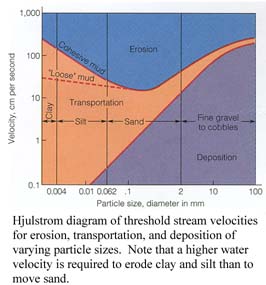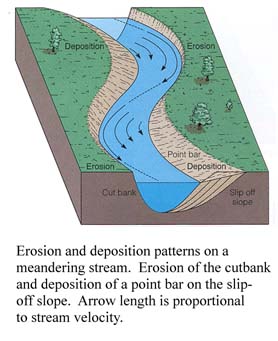| FLUVIAL
PROCESSES |
||
| Water is one of the most
powerful forces known and has been harnessed by humans for thousands of years. Even
today, the combined strength of water and gravity power mills and run hydroelectric power
generating stations. All ecosystems on earth are shaped and influenced by water, or a lack of water. The eastern United States is a living, life-sized tribute to the action of water and rivers. Fast moving water can move very large particles, as this diagram shows. As water slows down, it starts to deposit particles. This power of flowing water was responsible for the formation of the Coastal Plain. Sediments eroded from the Piedmont over thousands of years and were carried down gushing rivers towards the sea. |
|
|
| As a river flows, it
deposits sediments at intervals. These deposition spots change the velocity of the
river and encourage the deposition of more sediments. The river soon takes on a
winding, meandering shape as continued erosion and deposition occur. These forces of erosion and deposition happen continually. Sometimes the effect of these processes is obvious overnight after a torrential rain. Other times, the subtle movement of the streamcourse may not be visible at all in the course of a human lifetime. However, rivers always move. Human attempts to confine and alter the flow of river are usually not successful in the long run. It is wiser to stay out of the floodplain and build in upland locations. |
|
|
|
|
REFERENCES
|



